Satas D., Tracton A.A. (ed.). Coatings Technology Handbook
Подождите немного. Документ загружается.

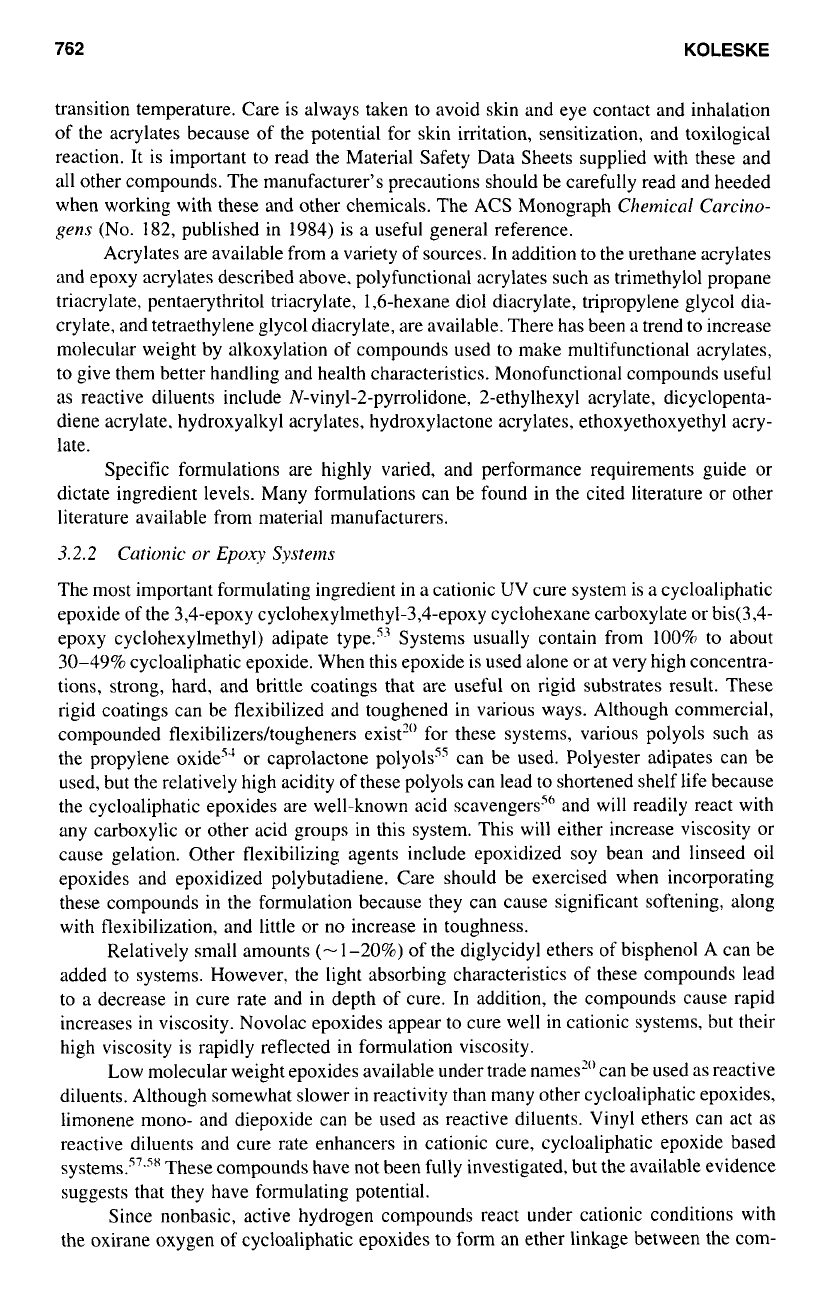
762
KOLESKE
transition temperature. Care is always taken to avoid skin and eye contact and inhalation
of
the acrylates because
of
the potential for skin irritation, sensitization, and toxilogical
reaction. It is important to read the Material Safety Data Sheets supplied with these and
all other compounds. The manufacturer’s precautions should be carefully read and heeded
when working with these and other chemicals. The ACS Monograph
Chemical Carcino-
gens
(No. 182, published in 1984) is a useful general reference.
Acrylates are available from a variety of sources. In addition to the urethane acrylates
and epoxy acrylates described above. polyfunctional acrylates such as trimethylol propane
triacrylate, pentaerythritol triacrylate, 1,6-hexane diol diacrylate, tripropylene glycol dia-
crylate, and tetraethylene glycol diacrylate, are available. There has been a trend to increase
molecular weight by alkoxylation
of
compounds used
to
make multifunctional acrylates,
to give them better handling and health characteristics. Monofunctional compounds useful
as reactive diluents include N-vinyl-2-pyrrolidone, 2-ethylhexyl acrylate, dicyclopenta-
diene acrylate, hydroxyalkyl acrylates, hydroxylactone acrylates, ethoxyethoxyethyl acry-
late.
Specific formulations are highly varied, and performance requirements guide or
dictate ingredient levels. Many formulations can be found in the cited literature or other
literature available from material manufacturers.
3.2.2
Cationic
or
Epoxy
Systems
The most important formulating ingredient in a cationic UV cure system is a cycloaliphatic
epoxide of the 3,4-epoxy
cyclohexylmethyl-3,4-epoxy
cyclohexane carboxylate or bis(3,4-
epoxy cyclohexylmethyl) adipate type.53 Systems usually contain from 100%
to
about
30-49% cycloaliphatic epoxide. When this epoxide is used alone or at very high concentra-
tions, strong, hard, and brittle coatings that are useful on rigid substrates result. These
rigid coatings can be flexibilized and toughened in various ways. Although commercial,
compounded flexibilizershougheners exist”’ for these systems, various polyols such as
the propylene oxide5‘ or caprolactone polyols55 can be used. Polyester adipates can be
used, but the relatively high acidity of these polyols can lead
to
shortened shelf life because
the cycloaliphatic epoxides are well-known acid scavengers5” and will readily react with
any carboxylic or other acid groups
in
this system. This will either increase viscosity or
cause gelation. Other flexibilizing agents include epoxidized soy bean and linseed oil
epoxides and epoxidized polybutadiene. Care should be exercised when incorporating
these compounds in the formulation because they can cause significant softening, along
with flexibilization, and little or no increase in toughness.
Relatively small amounts
(-
1-20%) of the diglycidyl ethers of bisphenol A can be
added
to
systems. However, the light absorbing characteristics
of
these compounds lead
to a decrease in cure rate and in depth of cure. In addition, the compounds cause rapid
increases in viscosity. Novolac epoxides appear to cure well in cationic systems, but their
high viscosity is rapidly reflected in formulation viscosity.
Low molecular weight epoxides available under trade nan1es”’can be used as reactive
diluents. Although somewhat slower in reactivity than many other cycloaliphatic epoxides,
limonene mono- and diepoxide can be used as reactive diluents. Vinyl ethers can act as
reactive diluents and cure rate enhancers in cationic cure, cycloaliphatic epoxide based
sy~terns.”~~~ These compounds have not been fully investigated, but the available evidence
suggests that they have formulating potential.
Since nonbasic, active hydrogen compounds react under cationic conditions with
the oxirane oxygen of cycloaliphatic epoxides to form an ether linkage between the com-
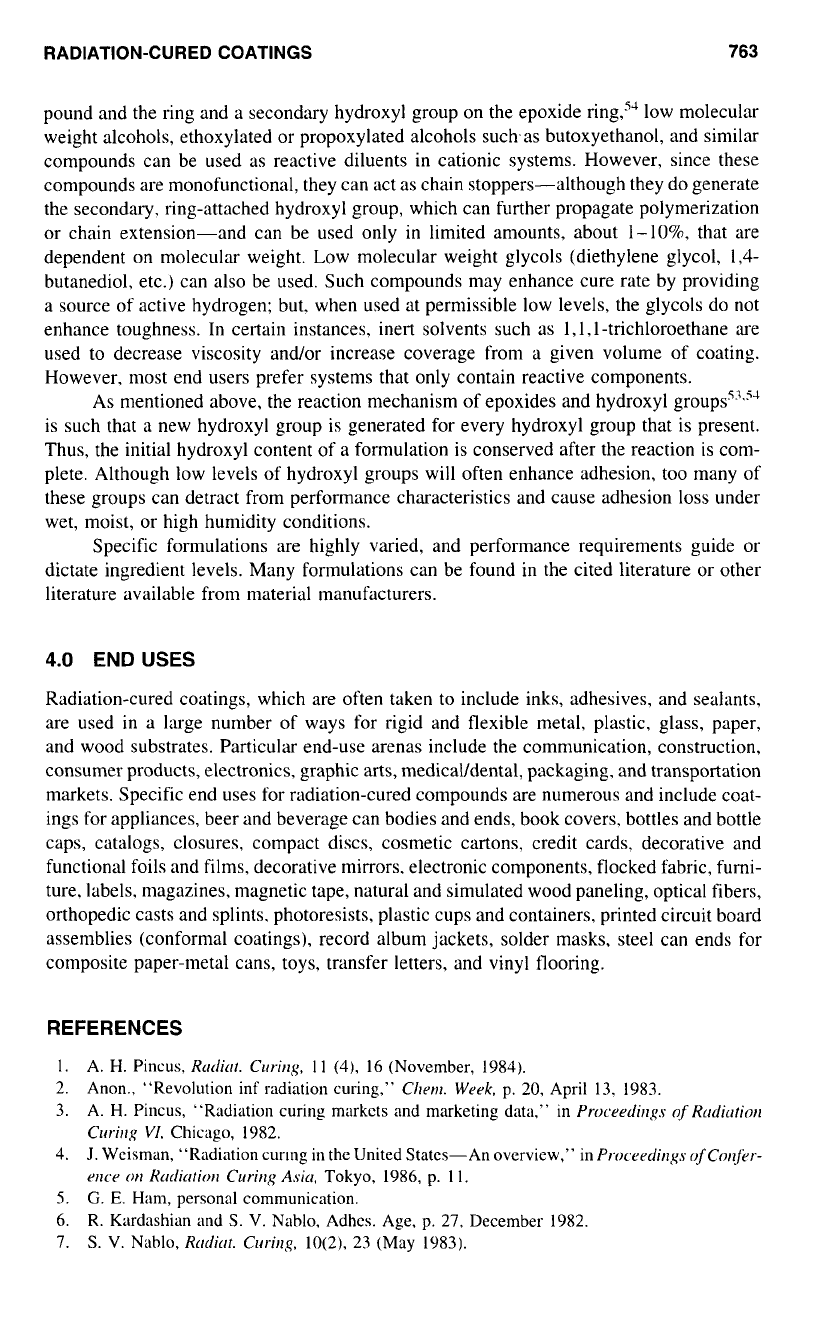
RADIATION-CURED COATINGS
763
pound and the ring and a secondary hydroxyl group on the epoxide rings4 low molecular
weight alcohols, ethoxylated or propoxylated alcohols such,as butoxyethanol, and similar
compounds can be used as reactive diluents in cationic systems. However, since these
compounds are monofunctional, they can act as chain stoppers-although they do generate
the secondary. ring-attached hydroxyl group, which can further propagate polymerization
or chain extension-and can be used only in limited amounts, about 1-10%, that are
dependent on molecular weight.
Low
molecular weight glycols (diethylene glycol, 1,4-
butanediol, etc.) can also be used. Such compounds may enhance cure rate by providing
a source of active hydrogen; but. when used at permissible low levels, the glycols do not
enhance toughness. In certain instances, inert solvents such as l,l,l-trichloroethane are
used to decrease viscosity and/or increase coverage from a given volume
of
coating.
However, most end users prefer systems that only contain reactive components.
is such that a new hydroxyl group is generated for every hydroxyl group that is present.
Thus, the initial hydroxyl content of a formulation is conserved after the reaction is com-
plete. Although low levels
of
hydroxyl groups will often enhance adhesion, too many of
these groups can detract from performance characteristics and cause adhesion loss under
wet, moist, or high humidity conditions.
Specific formulations are highly varied, and performance requirements guide or
dictate ingredient levels. Many formulations can be found in the cited literature or other
literature available from material manufacturers.
As mentioned above, the reaction mechanism
of
epoxides and hydroxyl
4.0 END USES
Radiation-cured coatings, which are often taken to include inks, adhesives, and sealants,
are used in
a
large number of ways for rigid and flexible metal, plastic, glass, paper,
and wood substrates. Particular end-use arenas include the communication, construction,
consumer products, electronics, graphic arts, medical/dental, packaging. and transportation
markets. Specific end uses for radiation-cured compounds are numerous and include coat-
ings for appliances, beer and beverage can bodies and ends, book covers. bottles and bottle
caps, catalogs, closures, compact discs, cosmetic cartons, credit cards, decorative and
functional foils and films, decorative mirrors, electronic components, flocked fabric, furni-
ture, labels. magazines, magnetic tape, natural and simulated wood paneling, optical fibers,
orthopedic casts and splints, photoresists, plastic cups and containers, printed circuit board
assemblies (conformal coatings), record album jackets, solder masks, steel can ends for
composite paper-metal cans, toys. transfer letters, and vinyl flooring.
REFERENCES
1.
A. H. Pincus,
Roditrr.
Cwing,
I1
(4),
16 (November, 1984).
2.
Anon., “Revolution inf radiation curing.”
Cllenl.
Week,
p. 20, April
13.
1983.
3. A. H. Pincus, “Radiation curing markets and marketing data,” in
Proceedings
of
Rrrtlidorl
4.
J.
Weisman, “Radiation curmg in the United States-An overview,” in Ploceedirlg.~
r,fCor!fer-
S.
G.
E.
Ham, personal communication.
6.
R. Kordashian and
S.
V.
Nablo,
Adhes. Age, p.
27,
December 1982.
7.
S.
V.
Nablo,
Rrrdirrf.
Curing.
10(2),
23 (May 1983).
C~irr~q
VI.
Chicago, 1982.
CIIW
on
Krrrlicrfiorl
Curing
As~L~,
Tokyo, 1986, p.
11.
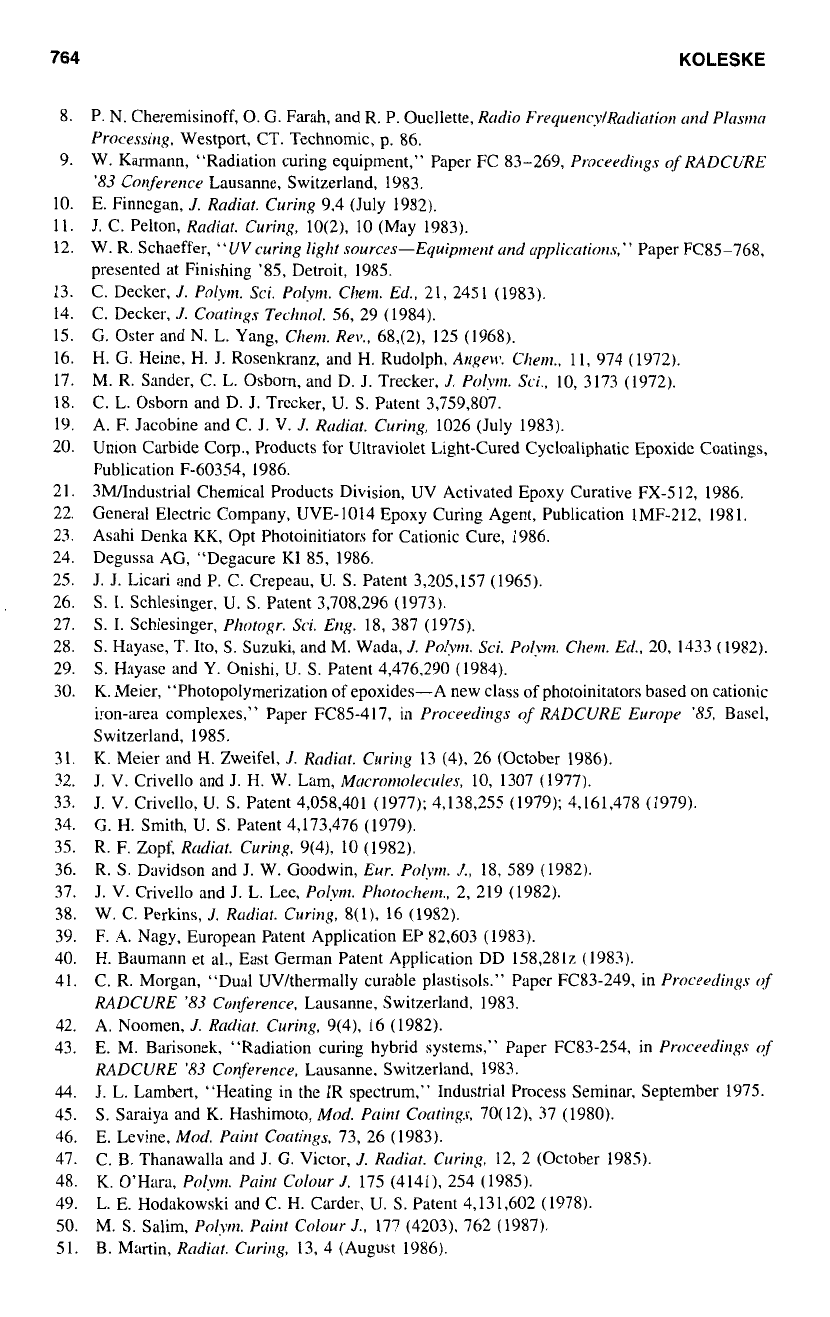
764
KOLESKE
8.
P. N. Cheremisinoff,
0.
G. Farah, and R. P. Ouellette,
Radio Frecluelicy/Rrrdiotioli
ctnd
Plrrsrm
9. W. Karmann, “Radiation curing equipment,” Paper FC 83-269,
Proceerlirrgs
of
RADCURE
Processing.
Westport, CT. Technomic,
p.
86.
‘83
Corzfererzce
Lausannc, Switzerland, 1983.
IO.
E. Finncgan,
J.
Radirrt.
Curing
9.4 (July 1982).
11.
J.
C. Pelton,
Rarlicrf.
Curing,
10(2),
IO
(May 1983).
12. W. R. Schaeffer,
“UVcuring
light
sources-Equipnierrt
rmd
crpplicntiorls,”
Paper FC85-768,
presented at Finishing
’85,
Detroit, 1985.
13. C. Decker,
J.
Polytn.
Sei.
Polynl.
Chertz.
Ed.,
21, 2451 (1983).
14. C. Decker,
J.
Coatings
Techno/.
56, 29 (1984).
15.
G. Oster and N. L. Yang,
Chetn.
Rev.,
68,(2), I25 (1968).
16. H.
G.
Heine, H. J. Rosenkranz, and H. Rudolph,
Angett’.
Chenz..
1
I,
974 (1972).
17. M. R. Sander, C. L. Osborn, and D.
J.
Trecker,
J.
Polwz.
Sci..
IO,
3173 (1972).
18.
C. L. Osborn and D.
J.
Trccker, U.
S.
Patent 3,759,807.
19.
A. F. Jacobine and C.
J.
V.
J.
Rdint.
Curing,
1026 (July 1983).
20. Union Carbide Corp., Products
for
Ultraviolet Light-Cured Cycloaliphatic Epoxidc Coatings,
21. 3Mhdustrial Chemical Products Division, UV Activated Epoxy Curative FX-5 12, 1986.
22. Gcneral Electric Company, UVE-1014 Epoxy Curing Agent, Publication 1MF-212, 1981.
23. Asahi Denka
KK,
Opt Photoinitiators
for
Cationic Cure, 1986.
24. Degussa AG, “Degacure
K1
85,
1986.
25. J.
J.
Licari and P. C. Crepcau, U.
S.
Patent 3,205,157 (1965).
26.
S.
I.
Schlesinger, U.
S.
Patent 3,708,296 (1973).
27.
S.
I.
Schlesinger,
Photogr.
Sci.
Eng.
18, 387 (1975).
28.
S.
Hayase,
T.
Ito,
S.
Suzuki, and M. Wada,
J.
Polynr.
Sei.
Polwz.
Clrern.
Ed.,
20, 1433 (1982).
29.
S.
Hayase and Y. Onishi, U.
S.
Patent 4,476.290 (1984).
30.
K.
Meier, “Photopolymerization
of
epoxides-A new class of photoinitators based on cationic
iron-area complexes,” Paper FC85-417,
in
Proceedirrgs
of
RADCURE
Europe
’85.
Basel,
Switzerland, 1985.
Publication F-60354, 1986.
31.
K. Meier and H. Zweifel,
J.
Rndirrt.
Curing
13 (4). 26 (October 1986).
32.
J.
V. Crivello and J. H.
W.
Lam,
Mrrcroniolecules.
10,
1307 (1977).
33.
J.
V. Crivello,
U.
S.
Patent 4,058,401 (1977); 4,138,255 (1979); 4,161,478 (1979).
34.
G.
H. Smith, U.
S.
Patent 4,173,476 (1979).
35. R. F.
Zopf,
Radint.
Curing.
9(4),
10
(1982).
36. R.
S.
Davidson and J. W. Goodwin,
Eur.
Polynz.
J.,
18,
589 (1982).
37.
J.
V. Crivello and
J.
L. Lee,
Pol.vrn.
Photochrrrz.,
2, 219 (1982).
38. W. C. Perkins,
J.
Rodinr.
Curing,
8(1),
16 (1982).
39. F. A. Nagy, European Patent Application EP 82,603 (1983).
40. H. Baumann et al., East German Patent Application DD 158,2811. (1983).
41. C. R. Morgan, “Dual UV/thermally curable plastisols.” Paper FC83-249, in
Proceedings
((f
42. A. Noomen,
J.
Rcrrlirrt.
Curing.
9(4), 16 (1982).
43. E. M. Barisonek, “Radiation curing hybrid systems,” Paper FC83-254, in
Proceedirigs
r?f
44.
J.
L. Lambert, “Heating in the IR spectrum,” Industrial Process Seminar, September 1975.
45.
S.
Saraiya and K. Hashimoto,
Mod.
Paint
Corrtirzgs.
70(12), 37 (1980).
46. E. Levine,
Mod.
Pcrirrt
Conrings.
73, 26 (1983).
47. C. B. Thanawalla and J. G. Victor,
J.
Rodirrt.
Curing,
12, 2 (October 1985).
48.
K.
O’Hnra,
Polvnr.
Paint
Colour
J.
175 (41411, 254 (1985).
49. L.
E.
Hodakowski and C. H. Carder,
U.
S.
Patent 4,131,602 (1978).
50.
M.
S.
Salim,
Polyrn
Pnint
Colour
J.,
177 (4203). 762 (1987).
51. B. Martin,
Rndirct.
Curing,
13,
4
(August 1986).
RADCURE
’83
Cor$erence,
Lausanne, Switzerland, 1983.
RADCURE
’83
Conference.
Lausanne. Switzerland, 1983.
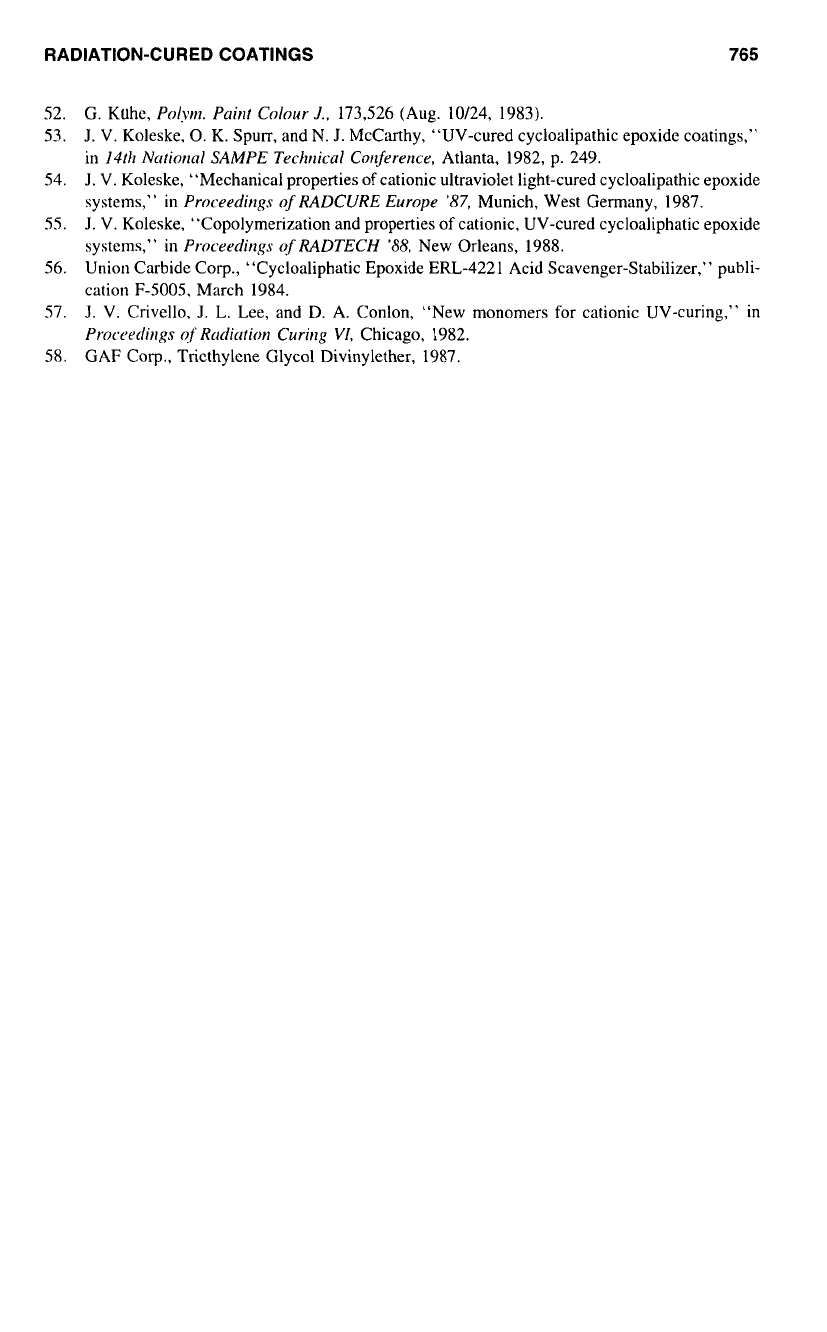
RADIATION-CURED COATINGS
765
52.
G.
Kuhc,
Polyn. Paint Colour
J..
173,526 (Aug. 10/24, 1983).
53.
J.
V. Koleske,
0.
K. Spurr, and N.
J.
McCarthy, “UV-cured cycloalipathic epoxide coatings,”
54.
J.
V. Koleske, “Mechanical properties
of
cationic ultraviolet light-cured cycloalipathic epoxide
SS.
J.
V. Koleske, “Copolymerization and properties
of
cationic, UV-cured cycloaliphatic epoxide
56. Union Carbide Corp., “Cycloaliphatic Epoxide
ERL-4221
Acid Scavenger-Stabilizer,” publi-
57.
J.
V. Crivello,
J.
L. Lee, and
D.
A. Conlon, “New monomers
for
cationic UV-curing,” in
58. GAF Corp., Triethylcne Glycol Divinylether, 1987.
in
14th
Ncltiorzal
SAMPE
Technical Corlference,
Atlanta, 1982, p. 249.
systems,” in
Proceedirzgs
of
RADCURE Europe
‘87,
Munich, West Germany, 1987.
systems,” in
Proceedings ofRADTECH
’88.
New Orleans, 1988.
cation
F-5005.
March 1984.
Procwditlgs
of
Rdiation Curirq
VI,
Chicago, 1982.
This Page Intentionally Left Blank
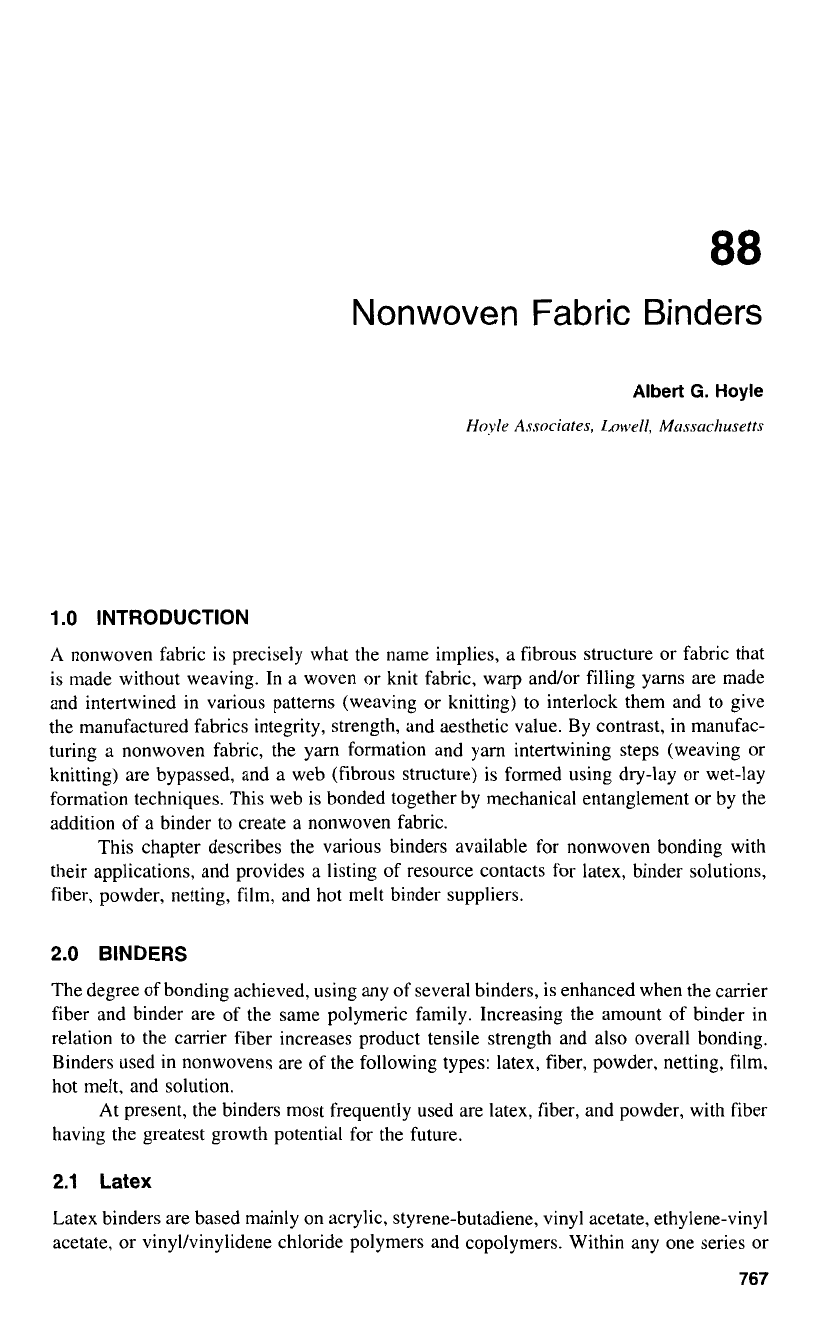
Nonwoven
Fabric
Binders
Albert G.
Hoyle
Hoyle
Associntes,
Lorveil,
Mussncllusetts
1
.O
INTRODUCTION
A
nonwoven fabric is precisely what the name implies, a fibrous structure or fabric that
is made without weaving. In a woven or knit fabric, warp and/or filling yarns are made
and intertwined in various patterns (weaving or knitting)
to
interlock them and to give
the manufactured fabrics integrity, strength, and aesthetic value. By contrast, in manufac-
turing
a
nonwoven fabric, the yarn formation and yam intertwining steps (weaving or
knitting) are bypassed, and
a
web (fibrous structure) is formed using dry-lay or wet-lay
formation techniques. This web is bonded together by mechanical entanglement or by the
addition of
a
binder to create
a
nonwoven fabric.
This chapter describes the various binders available for nonwoven bonding with
their applications, and provides
a
listing
of
resource contacts for latex, binder solutions,
fiber, powder, netting, film, and hot melt binder suppliers.
2.0
BINDERS
The degree
of
bonding achieved, using any of several binders, is enhanced when the carrier
fiber and binder are of the same polymeric family. Increasing the amount of binder in
relation to the carrier fiber increases product tensile strength and
also
overall bonding.
Binders used in nonwovens are
of
the following types: latex, fiber, powder, netting, film,
hot melt, and solution.
At present, the binders most frequently used are latex, fiber, and powder, with fiber
having the greatest growth potential for the future.
2.1
Latex
Latex binders are based mainly on acrylic, styrene-butadiene, vinyl acetate, ethylene-vinyl
acetate, or vinylhinylidene chloride polymers and copolymers. Within any one series or
767
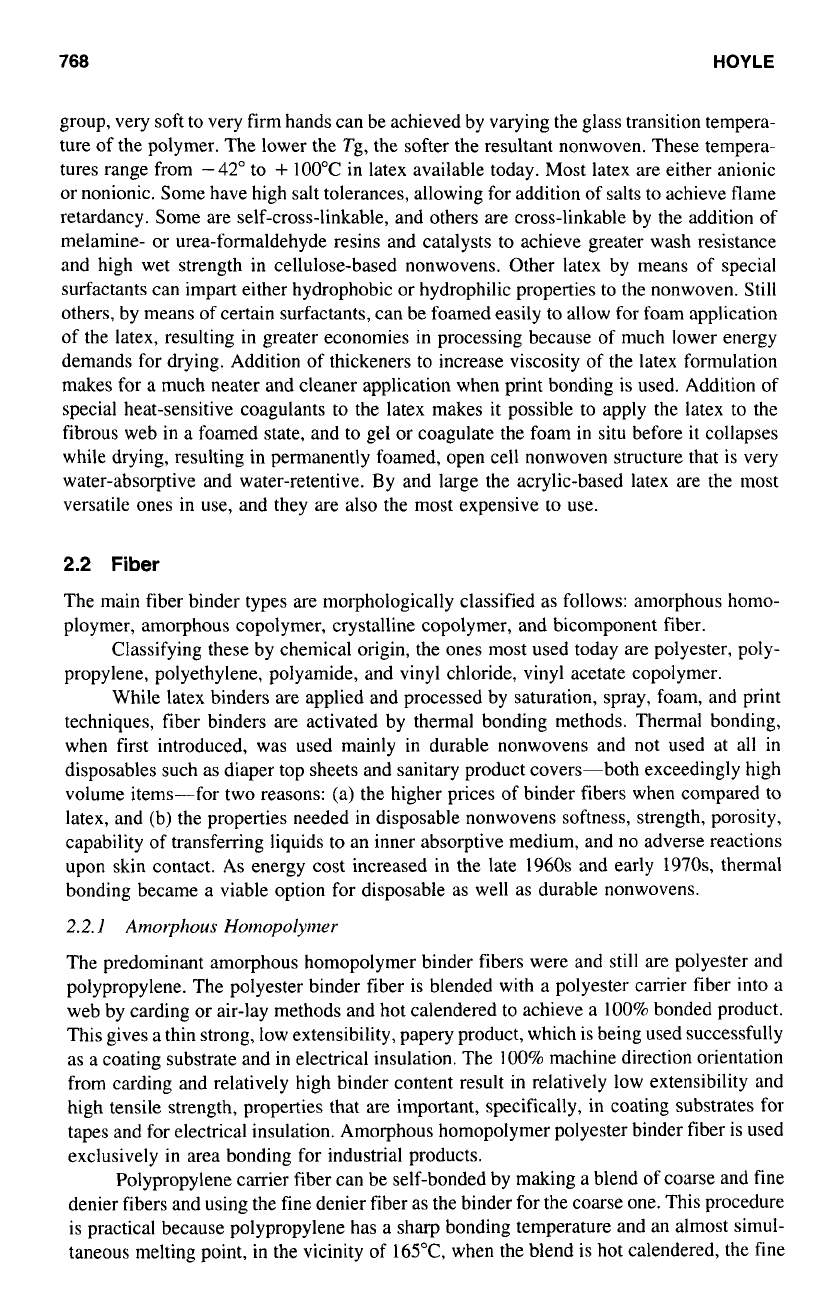
768
HOYLE
group, very soft
to
very firm hands can be achieved by varying the glass transition tempera-
ture of the polymer. The lower the
Tg,
the softer the resultant nonwoven. These tempera-
tures range from
-42"
to
+
100°C in latex available today. Most latex are either anionic
or nonionic. Some have high salt tolerances, allowing for addition
of
salts to achieve flame
retardancy. Some are self-cross-linkable, and others are cross-linkable by the addition of
melamine-
or
urea-formaldehyde resins and catalysts to achieve greater wash resistance
and high wet strength in cellulose-based nonwovens. Other latex by means of special
surfactants can impart either hydrophobic or hydrophilic properties to the nonwoven. Still
others, by means of certain surfactants, can be foamed easily to allow for foam application
of
the latex, resulting in greater economies in processing because of much lower energy
demands for drying. Addition of thickeners to increase viscosity of the latex formulation
makes for a much neater and cleaner application when print bonding is used. Addition of
special heat-sensitive coagulants
to
the latex makes it possible
to
apply the latex to the
fibrous web in a foamed state, and to gel or coagulate the foam in situ before it collapses
while drying, resulting in permanently foamed, open cell nonwoven structure that is very
water-absorptive and water-retentive. By and large the acrylic-based latex are the most
versatile ones in use, and they are also the most expensive
to
use.
2.2
Fiber
The main fiber binder types are morphologically classified as follows: amorphous homo-
ploymer, amorphous copolymer, crystalline copolymer, and bicomponent fiber.
Classifying these by chemical origin, the ones most used today are polyester, poly-
propylene, polyethylene, polyamide, and vinyl chloride, vinyl acetate copolymer.
While latex binders are applied and processed by saturation, spray, foam, and print
techniques, fiber binders are activated by thermal bonding methods. Thermal bonding,
when first introduced, was used mainly in durable nonwovens and not used at all
in
disposables such as diaper top sheets and sanitary product covers-both exceedingly high
volume items-for two reasons: (a) the higher prices of binder fibers when compared
to
latex, and (b) the properties needed in disposable nonwovens softness, strength, porosity,
capability of transferring liquids
to
an inner absorptive medium, and no adverse reactions
upon skin contact. As energy cost increased in the late
1960s
and early
1970s,
thermal
bonding became a viable option for disposable as well as durable nonwovens.
2.2.
I
Amorphous Hotnopolytner
The predominant amorphous homopolymer binder fibers were and still are polyester and
polypropylene. The polyester binder fiber is blended with a polyester carrier fiber into a
web by carding or air-lay methods and hot calendered to achieve a
100%
bonded product.
This gives a thin strong, low extensibility, papery product, which is being used successfully
as a coating substrate and in electrical insulation. The
100%
machine direction orientation
from carding and relatively high binder content result in relatively low extensibility and
high tensile strength, properties that are important, specifically, in coating substrates for
tapes and for electrical insulation. Amorphous homopolymer polyester binder fiber is used
exclusively in area bonding for industrial products.
Polypropylene carrier fiber can be self-bonded by making a blend of coarse and
fine
denier fibers and using the fine denier fiber as the binder for the coarse one. This procedure
is practical because polypropylene has a sharp bonding temperature and an almost simul-
taneous melting point, in the vicinity
of 165"C,
when the blend is hot calendered, the fine
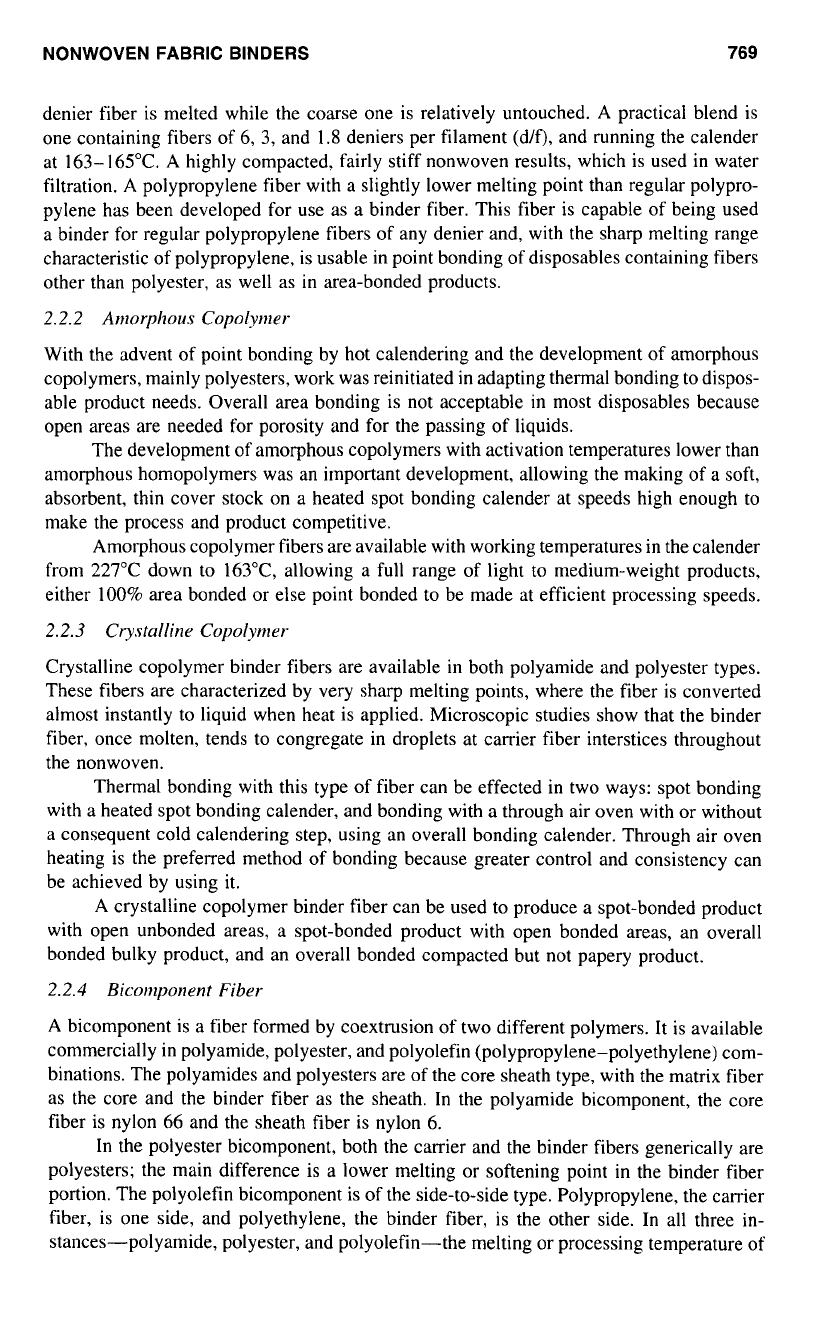
NONWOVEN FABRIC BINDERS
769
denier fiber is melted while the coarse one is relatively untouched. A practical blend is
one containing fibers
of
6,
3,
and
1.8
deniers per filament (d/f), and running the calender
at 163- 165°C. A highly compacted. fairly stiff nonwoven results, which is used in water
filtration. A polypropylene fiber with
a
slightly lower melting point than regular polypro-
pylene has been developed for use
as
a
binder fiber. This fiber is capable
of
being used
a
binder for regular polypropylene fibers of any denier and, with the sharp melting range
characteristic of polypropylene, is usable in point bonding of disposables containing fibers
other than polyester,
as
well
as
in area-bonded products.
2.2.2 Amorphous Copolymer
With the advent
of
point bonding by hot calendering and the development
of
amorphous
copolymers, mainly polyesters, work was reinitiated in adapting thermal bonding
to
dispos-
able product needs. Overall area bonding is not acceptable in most disposables because
open areas are needed for porosity and for the passing of liquids.
The development of amorphous copolymers with activation temperatures lower than
amorphous homopolymers was an important development, allowing the making of
a
soft,
absorbent, thin cover stock on
a
heated spot bonding calender at speeds high enough to
make the process and product competitive.
Amorphous copolymer fibers are available with working temperatures in the calender
from
227°C
down
to
163"C, allowing
a
full
range of light to medium-weight products,
either
100%
area bonded or else point bonded to be made at efficient processing speeds.
2.2.3 Crystalline Copolymer
Crystalline copolymer binder fibers are available in both polyamide and polyester types.
These fibers are characterized by very sharp melting points, where the fiber is converted
almost instantly to liquid when heat is applied. Microscopic studies show that the binder
fiber, once molten, tends to congregate in droplets at carrier fiber interstices throughout
the nonwoven.
Thermal bonding with this type of fiber can be effected in two ways: spot bonding
with
a
heated spot bonding calender, and bonding with
a
through air oven with or without
a
consequent cold calendering step, using an overall bonding calender. Through air oven
heating is the preferred method
of
bonding because greater control and consistency can
be achieved by using it.
A crystalline copolymer binder fiber can be used to produce
a
spot-bonded product
with open unbonded areas,
a
spot-bonded product with open bonded areas, an overall
bonded bulky product, and an overall bonded compacted but not papery product.
2.2.4 Biconlponent Fiber
A bicomponent is
a
fiber formed by coextrusion
of
two different polymers. It is available
commercially in polyamide, polyester, and polyolefin (polypropylene-polyethylene) corn-
binations. The polyamides and polyesters are of the core sheath type, with the matrix fiber
as
the core and the binder fiber as the sheath. In the polyamide bicomponent, the core
fiber
is
nylon 66 and the sheath fiber is nylon 6.
In the polyester bicomponent, both the carrier and the binder fibers generically are
polyesters; the main difference is
a
lower melting or softening point in the binder fiber
portion. The polyolefin bicomponent is
of
the side-to-side type. Polypropylene, the carrier
fiber, is one side, and polyethylene, the binder fiber, is the other side. In all three in-
stances-polyamide, polyester, and polyolefin-the melting or processing temperature of
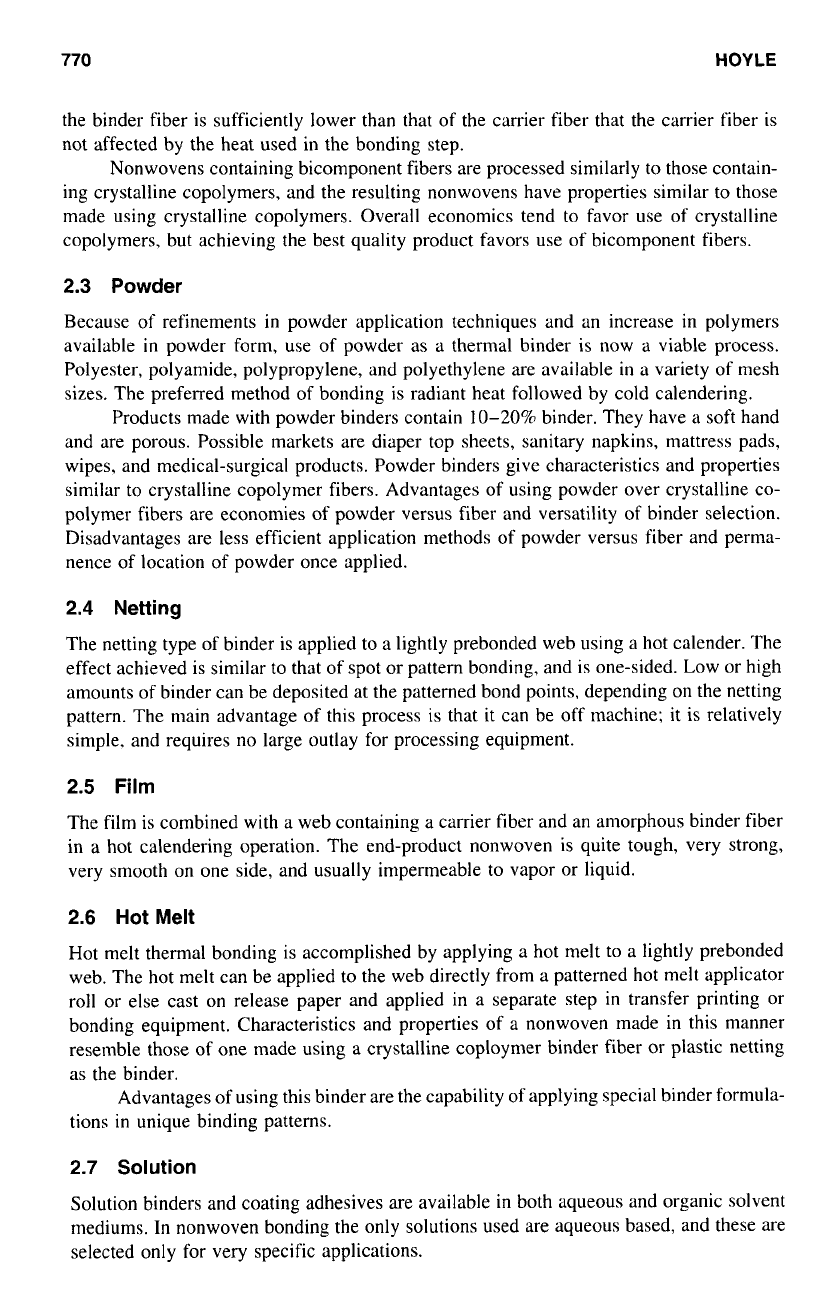
770
HOYLE
the binder fiber is sufficiently lower than that of the carrier fiber that the carrier fiber is
not affected by the heat used in the bonding step.
Nonwovens containing bicomponent fibers are processed similarly
to
those contain-
ing crystalline copolymers, and the resulting nonwovens have properties similar
to
those
made using crystalline copolymers. Overall economics tend
to
favor use of crystalline
copolymers, but achieving the best quality product favors use of bicomponent fibers.
2.3
Powder
Because of refinements in powder application techniques and an increase in polymers
available
in
powder form, use of powder as a thermal binder is now a viable process.
Polyester, polyamide, polypropylene, and polyethylene are available
in
a variety of mesh
sizes. The preferred method
of
bonding is radiant heat followed by cold calendering.
Products made with powder binders contain
10-20%
binder. They have a soft hand
and are porous. Possible markets are diaper top sheets, sanitary napkins, mattress pads,
wipes, and medical-surgical products. Powder binders give characteristics and properties
similar to crystalline copolymer fibers. Advantages of using powder over crystalline co-
polymer fibers are economies of powder versus fiber and versatility of binder selection.
Disadvantages are less efficient application methods of powder versus fiber and perma-
nence of location
of
powder once applied.
2.4
Netting
The netting type of binder is applied to a lightly prebonded web using
a
hot calender. The
effect achieved is similar to that of spot or pattern bonding, and is one-sided. Low or high
amounts of binder can be deposited at the patterned bond points, depending on the netting
pattern. The main advantage
of
this process
is
that it can be off machine; it is relatively
simple. and requires
no
large outlay for processing equipment.
2.5
Film
The film is combined with a web containing a carrier fiber and an amorphous binder fiber
in a hot calendering operation. The end-product nonwoven is quite tough, very strong,
very smooth on one side, and usually impermeable to vapor or liquid.
2.6
Hot Melt
Hot melt thermal bonding is accomplished by applying a hot melt to a lightly prebonded
web. The hot melt can be applied to the web directly from a patterned hot melt applicator
roll or else cast on release paper and applied in a separate step
in
transfer printing or
bonding equipment. Characteristics and properties of a nonwoven made
in
this manner
resemble those of one made using a crystalline coploymer binder fiber or plastic netting
as the binder.
Advantages
of
using this binder are the capability of applying special binder formula-
tions
in
unique binding patterns.
2.7 Solution
Solution binders and coating adhesives are available
in
both aqueous and organic solvent
mediums. In nonwoven bonding the only solutions used are aqueous based, and these are
selected only for very specific applications.
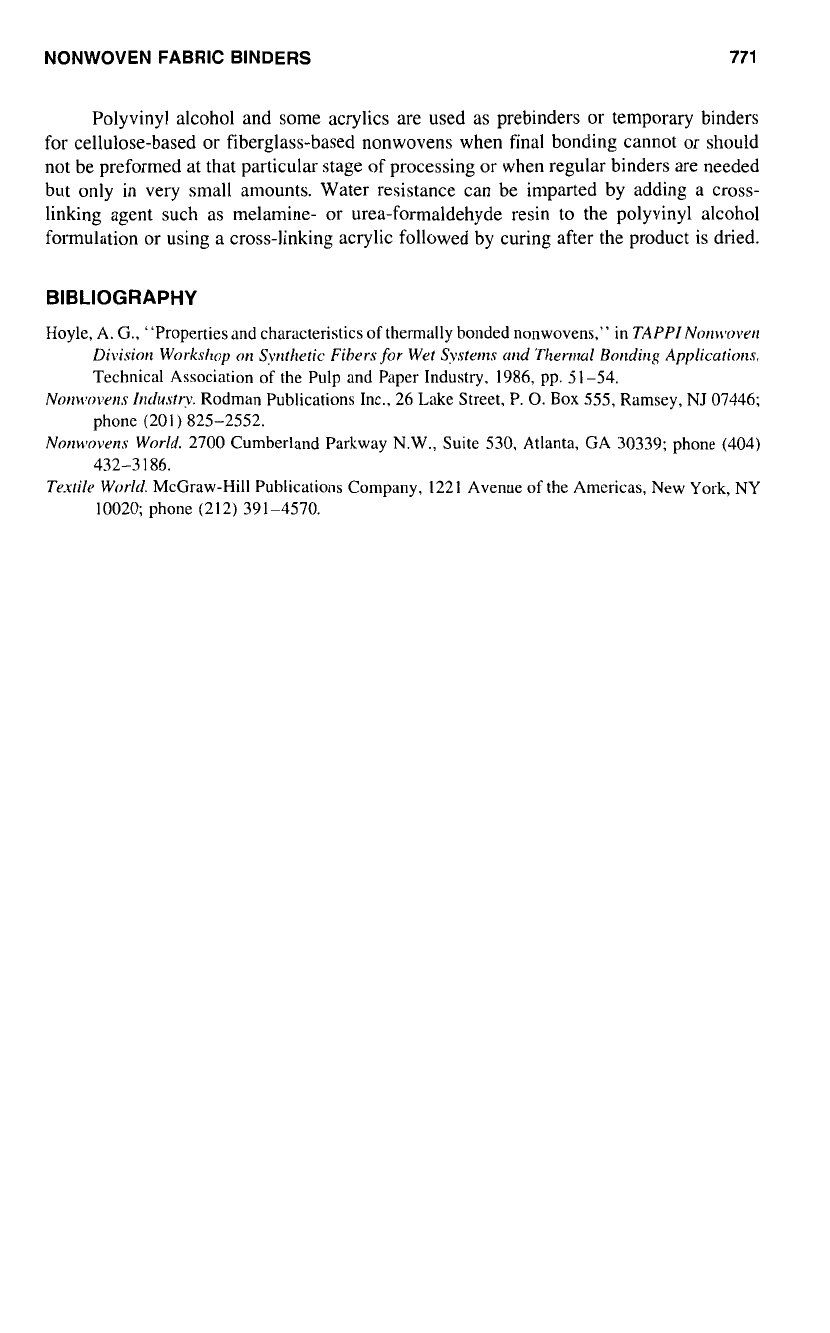
NONWOVEN FABRIC BINDERS
771
Polyvinyl alcohol and some acrylics are used
as
prebinders or temporary binders
for cellulose-based or fiberglass-based nonwovens when final bonding cannot or should
not be preformed at that particular stage of processing or when regular binders are needed
but only
in
very small amounts. Water resistance can be imparted by adding a cross-
linking agent such
as
melamine- or urea-formaldehyde resin to the polyvinyl alcohol
formulation or using a cross-linking acrylic followed by curing after the product is dried.
BIBLIOGRAPHY
Hoyle, A. G., “Properties and characteristics
of
thermally bonded nonwovens,” in
TAPPlNor~wover~
Divisinrt
Worksltop
on
Sytltl~etic
Fibers
for
Wet
Systerns
cold
Tlterrlzul
Bortdirtg
Applications,
Technical Association
of
the Pulp and Paper Industry, 1986, pp.
5
1-54.
Nor~wo~ws
lrtdu.stt:v.
Rodman Publications Inc., 26 Lake Street,
P.
0.
Box
555,
Ramsey,
NJ
07446;
phone (201) 825-2552.
Norzn~ovens
World.
2700 Cumberland Parkway N.W., Suite 530, Atlanta, GA 30339; phone (404)
Textile
World.
McGraw-Hill Publications Company, 1221 Avenue
of
the Americas, New York, NY
432-3 186.
10020; phone (2 12) 39 1-4570.
